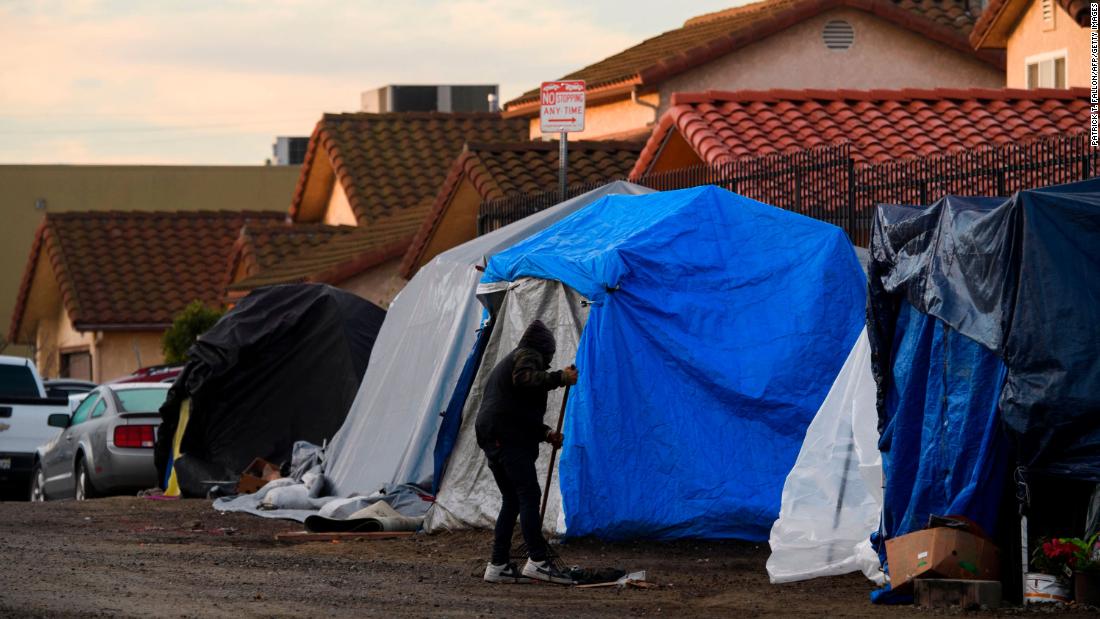
Outrage and fear about homelessness never seems to lead to the obvious choice

Deborah Padgett (@DeborahPadgett5) is a professor at the NYU Silver School of Social Work whose research centers on homeless adults and mental health services. She is the co-author of “Housing First: Ending Homelessness, Changing Systems and Transforming Lives.” The views expressed here are her own. Read more opinion on CNN.
(CNN)We have been here before — the horrific scene of a disheveled man experiencing homelessness suddenly attacking a stranger in New York City. Five homeless men in New York and Washington, DC, shot, two killed. Some corners of the media seized upon police descriptions of these incidents — citing the intersection of homelessness, drug use and mental illness to craft morality tales of untethered madness and bedlam on city streets. Public outcries once again converged on the urgent need to do something.
Having spent decades engaged in research on the needs of persons experiencing homelessness and mental illness, I continue to marvel at how outrage and fear never seem to lead to the political will to make better, more effective social policies.
Public mental health clinicians are heroes in choosing to work in a woefully under-resourced system that is overloaded with patients who need far more than an occasional 10-minute “med check” visit with a psychiatrist. But it is the patients who ultimately pay the highest price in a society that stigmatizes and shuns them. A healthy recovery is difficult to achieve living without a home and depending on a system that is itself broken.
Political leaders such as New York City mayor Eric Adams decry the plight of those experiencing homelessness and promise more and better shelters and permanent housing. But the city’s initial response was the all-too-familiar reliance on police tactics such as sweeps of encampments and the subway system.
Starting in mid-March, massive sweeps in subways and highway underpasses removed 239 of the 244 encampments known to city authorities. Of those rousted, only five agreed to go to a shelter — an indication of the dangers and discomfort of crowded shelters. This scenario is played out in cities around the country.
Having watched such clearings, I am left with a sense of futility as encampment residents helplessly watch their worldly belongings tossed into sanitation dump trucks, then make plans to regroup at another location.
As to solutions for homelessness, the research evidence is irrefutable. An approach known as Housing First has challenged traditional shelter-based policies by offering immediate access to independent housing to homeless persons with serious mental illness. Housing First is not “housing only,” it includes an array of support services needed to live stably in the community.

Multi-national studies — including “gold standard” randomized trials in the US, Canada and France — show that Housing First ends homelessness for 75 to 95% of people with mental illness by providing immediate access to housing along with 24/7 support services to ensure that their needs — mental, physical and instrumental (food, transportation, money management, job training and so on) — are met. Costing less than a bed in a shelter, a jail or a hospital, Housing First’s success depends in large part on its attention to attaining hard-won trust.
The Covid-19 pandemic came along just as the number of homeless Americans was rising, especially in Los Angeles and New York City. Oddly enough, this terrible malady made possible a major shift in homeless services as unused hotel rooms were filled with thousands of homeless persons moved from crowded shelters and encampments to counteract “superspreader” living conditions.
The differences between these two cities — New York and Los Angeles — could not be greater. New York offers a legally mandated right to shelter and spends billions each year on a massive network of shelters and supportive housing (the latter reserved for homeless persons with serious mental illness or other disability).
One can only wonder how many homeless families and individuals could be housed and rent-subsidized with these funds considering that a shelter bed in New York City costs over $3,000 a month. To paraphrase Malcolm Gladwell, sometimes it is easier to manage homelessness than to end it.
Until relatively recently, Los Angeles tended to tolerate homeless people as long as they were corralled into downtown’s Skid Row and other encampments largely out of sight. San Francisco’s level of tolerance extended to allowing homeless encampments located close to luxury hotels and shops.
Yet even before the pandemic, such hands-off approaches had become untenable, and many cities and the state of California sought to fund and build affordable housing to address what was becoming an “uncontainable” problem as homeless persons were camping on beaches, in parks and on the streets of affluent neighborhoods.
Starting with Project RoomKey and then morphing into Project HomeKey, the state under Gov. Gavin Newsom embarked upon a concerted effort to house homeless persons, whether in “tiny homes,” sanctioned tent cities or apartments in new or re-purposed buildings.
Notwithstanding its tragic impact, the pandemic opened doors, literally, to hotel and motel rooms sitting vacant. Giving homeless people a respite not only from Covid but from the many travails of street living, a glimmer of hope emerged from the viral scourge.
In Seattle and in some cities in California, the political will was there to make hotels into housing and the Biden administration obliged with additional funding through the CARES Act.
And yet the heavy hand of the bureaucratic status quo had to make its presence known. Converting and retrofitting hotels into modest but livable accommodations required changes in zoning laws and expediting building permits, as well as finding developers willing to use their capital funds to purchase the hotels then renovate them with federal and state funding.
Formal audits and budget reckonings revealed a shocking amount of California’s funds designated for housing has gone unspent due to risk-averse local political leaders and rising building costs. Unspent federal funds present a frustrating dilemma to housing advocates in many parts of the US.
Where are we now? Some progress has been made in creating new housing units in California, but the need far outweighs the supply and the gap is widening. In the summer of 2021, New York City’s Department of Homeless Services moved over 9,000 hotel residents back to the crowded shelters from whence they came despite continued available funding from FEMA.
The election of Mayor Eric Adams in New York City and ascendance of new Gov. Kathy Hochul was the occasion for optimism followed by a familiar letdown as state and city leaders announced modest increases in funding for housing.
However, even that uptick in political will dissipated as encampment sweeps and policing the subways became the go-to move for political leaders outraged by the tragic killings that took place.
In summary, California’s homeless response has been directed to housing rather than shelters, a policy moving in the right direction despite bureaucratic obstacles. New York’s homeless response has been dominated by shelters and the vast network of jobs and costly building leases necessary to keep the system viable under a “right to shelter” mandate. Most American cities pursue a hybrid of these two disparate responses. Time will tell if pandemic-driven funding increases will truly open doors to permanent housing for persons experiencing homelessness, and the time to act is now.
Meanwhile, we know that a person experiencing the anguish of mental illness and homelessness is not destined to murder a stranger. And we know that providing stable permanent housing with caring support can set in motion positive life changes. Public monies are better spent on realizing these goals than in activating police departments to use force and coercion to “manage” homeless people rather than put an end to their ultimate deprivation.
Source: https://www.cnn.com/2022/04/11/opinions/homelessness-solutions-mental-health-new-york-city-padgett/index.html


















